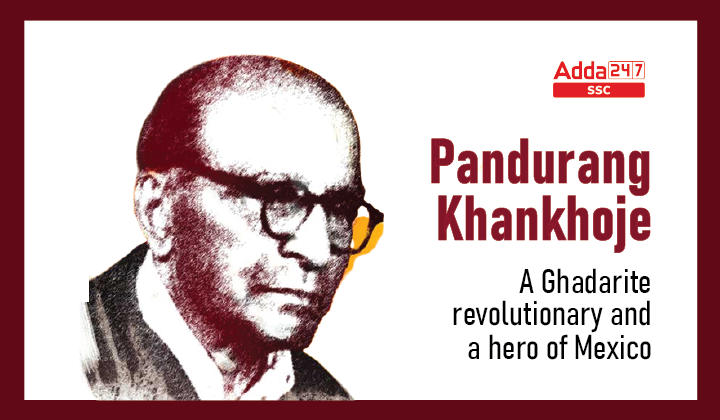Table of Contents
Pandurang Khankhoje- A Ghadarite revolutionary and a hero of Mexico- Relevance for UPSC
General Studies I- Modern History and the struggle for freedom.
In News
Lok Sabha Speaker Om Birla, who is currently in Canada for the 65th Commonwealth Parliamentary Conference, will travel to Mexico where he will unveil statues of Swami Vivekananda and Maharashtra-born freedom fighter and agriculturalist Pandurang Khankhoje (1883-1967).
Who was Pandurang Khankhoje?
- Born in Wardha, Maharashtra, in the late 19th century, Pandurang Khankhoje came in contact with other revolutionaries early on.
- His daughter Savitri Sawhney, who wrote his biography, wrote of his early years: “As a student, Khankhoje was an ardent admirer of the French Revolution and of the American War of Independence.
- Closer to home, the Hindu reformer Swami Dayanand and his Arya Samaj movement, which called for a spirit of reform and social change, became the hero to a young student group led by Khankhoje.”
On road to be a Revolutionary
- Khankhoje decided to go abroad for further training in revolutionary methods and militaristic strategy.
- At this time, the British government’s suspicions of him were also growing due to his anti-government activities.
- Before leaving, he visited Bal Gangadhar Tilak, by whom he was inspired. Tilak advised him to go to Japan, which was itself a strong, anti-West Asian imperialistic force then.
- After spending time with nationalists from Japan and China, Khankhoje eventually moved to the US, where he enrolled in college as a student of agriculture.
- But a year later, he joined the Mount Tamalpais Military Academy in California to fulfil his original purpose of leaving India.
Association with the Indian independence movement
- Khankhoje was one of the founding members of the Ghadar Party, established by Indians living abroad in 1914, mostly belonging to Punjab.
- Its aim was to lead a revolutionary fight against the British in India.
- While in the US, Khankhoje met Lala Har Dayal, an Indian intellectual teaching at Stanford University who had begun a propaganda campaign, publishing a newspaper that featured patriotic songs and articles in the vernacular languages of India. This was the seed from which the Ghadar Party would emerge.
The Ghadr Party
- The Ghadar Movement was an early 20th century, international political movement founded by expatriate Indians to overthrow British rule in India.
- Earlier activists had established a ‘Swadesh Sevak Home’ in Vancouver and a ‘United India House’ in Seattle to carry out revolutionary activities.
- Finally, in 1913, the Ghadr was founded.
- The Ghadar Party, originally known as the Pacific Coast Hindustan Association, was founded on July 15, 1913 in the US by Lala Har Dayal, Sant Baba Wasakha Singh Dadehar, Baba Jawala Singh, Santokh Singh, and Sohan Singh Bhakna.
- It fought against colonialism from 1914 to 1917, with the support of Imperial Germany and the Ottoman Empire, both of which were Central Powers opposed to the British.
- The party was organized around the weekly newspaper The Ghadar, which featured the masthead caption: Angrezi Raj Ka Dushman (an enemy of British rule); “Wanted brave soldiers to stir up rebellion in India,” the Ghadar declared.
How did Khankhoje reach Mexico?
- At the military academy, Khankhoje met many people from Mexico.
- The Mexican Revolution of 1910 had led to the overthrow of the dictatorial regime, and this inspired Khankhoje.
- He also reached out to Indians working on farms in the US with the aim of discussing the idea of Indian independence with them.
- Along with the Indian workers, militant action was planned by Khankhoje in India, but the outbreak of the First World War halted these plans.
- He then reached out to Bhikaji Cama in Paris, and met with Vladimir Lenin in Russia among other leaders, seeking support for the Indian cause.
- However, as he was facing possible deportation from Europe and could not go to India, he sought shelter in Mexico.
A Mexican Hero
- In part due to his prior friendship with Mexican revolutionaries, he was appointed a professor at the National School of Agriculture in Chapingo, near Mexico City.
- He researched corn, wheat, pulses and rubber, developing frost and drought-resistant varieties, and was part of efforts to bring in the Green Revolution in Mexico.
- Later on, the American agronomist Dr Norman Borlaug, called the Father of the Green Revolution in India, brought the Mexican wheat variety to Punjab.
- Khankhoje was revered as an agricultural scientist in Mexico.
- The renowned Mexican artist Diego Rivera painted murals that featured Khankhoje, including one titled ‘Our Daily Bread’ that prominently depicted him breaking bread with people seated around a table.
Return to India
- Pandurangreturned to India after 1947.
- His application for visa was initially rejected by the Indian government due to the ban by the British Indian Government, but was eventually overturned.
- He settled in Nagpur and subsequently embarked on a political career.
- Pandurang Khankhoje died on 22 January 1967.




 TSPSC Group 1 Question Paper 2024, Downl...
TSPSC Group 1 Question Paper 2024, Downl...
 TSPSC Group 1 Answer key 2024 Out, Downl...
TSPSC Group 1 Answer key 2024 Out, Downl...
 UPSC Prelims 2024 Question Paper, Downlo...
UPSC Prelims 2024 Question Paper, Downlo...
